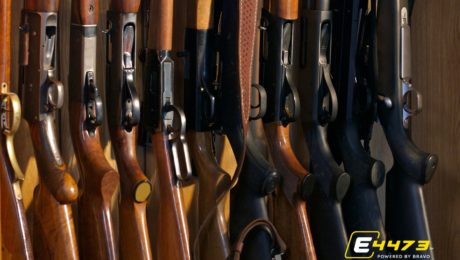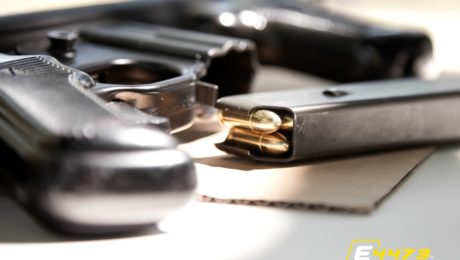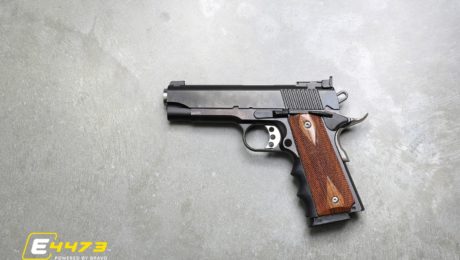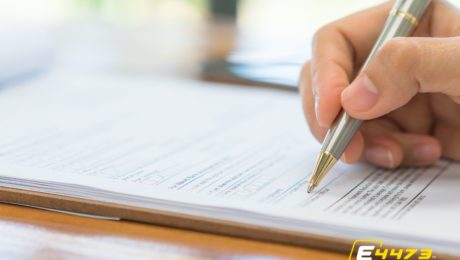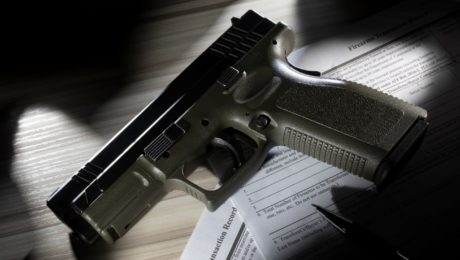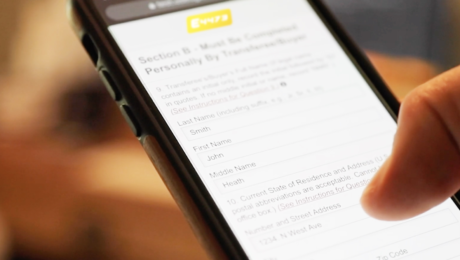Conquering ATF Audits: Best Software for Faster and Smoother Inspections
Monday, May 13 2024
For any firearms dealer, an ATF audit can trigger a wave of anxiety. The prospect of inspectors scrutinizing your records, inventory, and compliance procedures can be daunting. However, with the right tools and preparation, you can navigate ATF audits with confidence and minimize disruption to your business. This article dives deep into the importance of using software specifically designed to streamline ATF compliance for gun stores, Federal Firearms License (FFL) holders, and gun shops. We’ll explore the challenges of manual recordkeeping, the benefits of automation, and introduce you to Bravo Store Systems – a software solution that empowers you to conquer ATF audits with ease. The Perils of Paper Trails: Why Manual Systems Slow You Down Traditionally, FFLs and gun stores have relied on paper-based systems for recordkeeping. While this approach might seem manageable at first, it quickly becomes cumbersome as your business grows. Here’s how manual systems hinder your ability to prepare for and excel during ATF audits: Time-Consuming Data Entry: Manually entering gun sales information and inventory details is a tedious and error-prone process. This not only eats into your valuable time but also increases the risk of mistakes that could raise red flags during an audit. Data Inaccessibility: Locating specific records amidst a mountain of paperwork can be a nightmare. Auditors expect instant access to information, and delays in retrieving data can cast a negative light on your compliance practices. Inconsistent Recordkeeping: Maintaining consistent formatting and organization across paper records can be challenging. Inconsistencies can make it difficult for both you and auditors to track information and identify trends. Limited Reporting Capabilities: Extracting meaningful insights from handwritten logs is a near-impossible task. Without clear, concise reports, you’ll struggle to identify areas for improvement and optimize your compliance procedures. Embrace Automation: How Software Simplifies ATF Compliance Investing in software specifically designed for FFLs can revolutionize your approach to ATF compliance. Here’s how these tools empower you to streamline recordkeeping and conquer those audits: Effortless Data Entry: Software automates much of the data entry process, saving you countless hours and minimizing the risk of errors. Simply scan barcodes, enter digital signatures, and let the software handle the rest. Instantaneous Access: With a few clicks, you can access any transaction record, inventory item, or compliance document. This ensures that auditors can swiftly review the information they need. Standardized Recordkeeping: Software enforces consistent formatting and data entry practices across your records. This provides a clear and organized view of your operations for both internal review and external audits. Powerful Reporting and Analytics: Generate comprehensive reports that detail sales trends, inventory status, and compliance metrics. Utilize these insights to identify potential risks and proactively address any red flags before ATF arrives. Introducing Bravo Store Systems: Your All-in-One Compliance Solution Bravo Store Systems positions itself as the #1 point-of-sale (POS) software solution specifically designed for specialty retailers like gun stores. Their software goes beyond traditional POS functionality, offering a comprehensive suite of features that streamline ATF compliance: Integrated A&D Book Management: Maintain a digital A&D book with automatic updates for every FFl transaction. This ensures complete and accurate records for easy access during audits. Digital 4473 Management: Process background checks and electronically submit ATF Form 4473 directly through the software. This eliminates paper clutter and ensures timely submissions. Guaranteed Compliance: Bravo’s software incorporates industry best practices and regulatory updates to help you maintain compliance with ATF regulations. Real-Time Inventory Tracking: Track your inventory in real-time, ensuring accurate reporting and preventing discrepancies that could trigger scrutiny during audits. Detailed Reporting: Generate reports that detail gun sales, background checks, and compliance adherence. Utilize this data to identify trends and proactively address potential issues. 100% Uptime: Never worry about system downtime hindering your ability to access records. Bravo works hard to maintain100% uptime, so your data is always readily available. Beyond Software: Additional Tips for a Smooth ATF Audit While Bravo Store Systems provides a robust foundation for conquering ATF audits, here are some additional tips to ensure a smooth inspection: Be Prepared: Understand the ATF audit process and familiarize yourself with the required documentation. Organize your records electronically and maintain a clean, professional workspace. Designate a Point Person: Appoint a knowledgeable staff member to act as a liaison with the auditors. This ensures clear communication and streamlines the inspection process.
- Published in ATF
No Comments
How to fill out a 4473 as a FFL
Thursday, May 09 2024
As an FFL dealer, navigating the rules and regulations surrounding firearm sales is a critical part of your business operations. One of the most essential components of this process is ensuring that your customers accurately complete the ATF Form 4473. This federal document serves as a background check record and verifies the eligibility of the buyer. Failure to properly fill out this form can lead to legal consequences, making it imperative for both you and your customers to approach it with utmost care and attention to detail. Guiding your customers through the ATF Form 4473 is not only a compliance requirement but also an opportunity to demonstrate your commitment to responsible firearm sales. By taking the time to explain the form and assist your customers in providing accurate information, you can establish trust and credibility while ensuring a smooth and lawful transaction. Here’s a breakdown of the steps involved in filling out Form 4473, which can be shared with your customers: Part 1: Buyer Information (1) Firearm Transaction Record – This section identifies the form as ATF Form 4473. (2) Transaction Number – The dealer assigns a unique number for the transaction. (3) Type of Transfer – Indicate if it’s a new or used firearm. (4) FFL Information – The dealer fills this section with their Federal Firearms License (FFL) details. (5) Transferee (Buyer) Information – Enter your full legal name, address, date of birth, and contact information. (6) Alien Information (if applicable) – Complete this section if you’re not a U.S. citizen or legal resident. Part 2: Questionnaires (10) Are you the actual transferee of the firearm(s) being transferred? – Answer “Yes” if you’re the buyer acquiring the firearm. (11) Are you under indictment for a felony, or have you been convicted of a felony? – Honestly answer “Yes” or “No” based on your background. (12-19) Prohibitions – Answer “Yes” or “No” to questions regarding restraining orders, drug use, dishonorable discharge from the military, and other disqualifying factors. (20) Warning – Read the warning message thoroughly about the penalties for providing false information. Part 3: Additional Information (21) Description of Firearm(s) – The dealer will provide details about the firearm(s) being transferred, including caliber, model, and serial number. (22) Certification of Transferee – You’ll sign and certify that the information provided is true and correct. Part 4: FFL Information This section is reserved for the dealer to complete. They will verify the information you provided, initiate a background check through the National Instant Criminal Background System (NICS), and finalize the transfer process upon approval. Important Reminders Ensure all information is accurate and complete. Don’t leave any blanks; use “N/A” if a section doesn’t apply. Answer all questions truthfully; any false information can lead to serious consequences. Take your time while filling out the form and review it carefully before signing. As an FFL dealer, your role in completing the ATF Form 4473 is crucial. In Part 4, you will verify the information provided by the customer, initiate a background check through the National Instant Criminal Background Check System (NICS), and finalize the transfer process upon approval. Completing the ATF Form 4473 is a vital step in the legal firearm transfer process. By carefully guiding your customers through this process and ensuring accurate information is provided, you not only comply with federal regulations but also contribute to a safer and more transparent firearms industry. This level of diligence and responsibility can help strengthen your reputation as a trustworthy and compliant FFL dealer. It’s worth noting that the requirements and regulations surrounding firearms may vary across different states and jurisdictions. Therefore, it’s always advisable to stay up-to-date with any changes and seek guidance from relevant local authorities to ensure full compliance with all applicable laws and procedures.
- Published in ATF
Understanding the 4473 Denial Appeal Process
Monday, May 06 2024
As an FFL dealer, the ATF Form 4473 plays a crucial role in your firearms business operations. However, there may be instances when a potential customer’s application is denied. In such cases, understanding the denial appeal process is essential to ensure fairness and accuracy. Let’s delve into the details of the 4473 denial appeal process and explore how it works. The Basics of ATF Form 4473 Before we discuss the appeal process, let’s recap what the ATF Form 4473 entails: Purpose: The ATF Form 4473 serves as a record of the sale or transfer of a firearm. It collects essential information about the buyer, the firearm, and the transaction. Denial Situations: Sometimes, a potential customer may receive a denial due to various reasons, such as criminal history, mental health issues, or other disqualifying factors. The Appeal Process for FFL Dealers Erroneous Denial or Extended Delay If you believe a potential customer has been wrongly denied or has experienced an extended delay during a firearms transfer, they have the right to appeal. Here’s how: First Step: The customer should submit their appeal request to the agency that conducted the background check. This could be either the state point of contact or the FBI through the National Instant Criminal Background Check System (NICS). Alternative Route: Instead of appealing directly through the processing agency, the customer can choose to submit their appeal request to the FBI’s Criminal Justice Information Services (CJIS) Division’s NICS Section. Challenging the Record Accuracy The customer can challenge the accuracy of the record used as the basis for their denial or delay. Here are some options: Record Challenges: If the customer has additional information (such as court documentation), they should include it with their written correspondence to assist the NICS Section’s Appeal Services Team (AST) in correcting or updating the record. Questions of Identity: If the customer questions the identity of the criminal history record used for their denial or delay, they can have their fingerprints rolled or electronically scanned by law enforcement. Ensure that the fingerprint card is marked “For NICS Purposes.” Requesting an Appeal The customer should request the reason for their denial or delay from the FBI in writing via mail, facsimile, or online. Due to privacy regulations, the reason cannot be provided over the phone. The customer should include the following information with their appeal request: Complete Name Complete Mailing Address NICS Transaction Number (NTN) or State Transaction Number (STN) Optionally, include a set of their rolled fingerprints. Appealing a Delay If the customer experienced a delay, they must wait 30 days from the date of initiating the check before filing an appeal. The NICS Section’s staff needs time to complete the initial transaction. The customer should include the same required information as for denials, along with a set of their rolled fingerprints. Timelines A delayed transaction will be purged from the NICS within 88 days from creation. Understanding the 4473 denial appeal process is crucial for FFL dealers to ensure a smooth and compliant firearms business operation. By guiding potential customers through the appeal process, you can help resolve erroneous denials or delays, maintain transparency, and uphold accountability. Remember, responsible firearm sales involve understanding the legal framework and advocating for your customers’ rights within the established procedures. For more information, visit the FBI NICS Appeals website.
- Published in Uncategorized
What Questions are Asked on a 4473 Form?
Monday, April 22 2024
Form 4473 contains the purchaser’s name, address, date of birth, government-issued photo ID, National Instant Criminal Background Check System (NICS) background check transaction number, and a short affidavit stating that the purchaser is eligible to purchase firearms under federal law. This form is designed to ensure that the buyer is legally eligible to purchase firearms in the U.S. and to prevent firearms from falling into the wrong hands. The form has several sections, each requiring detailed information from the buyer and the seller. Section A: Buyer’s Personal Information and Eligibility The first section of the form collects the buyer’s personal information, including their full name, address, place of birth, height, weight, and other identifying details. It also includes questions about the buyer’s background and eligibility to own a firearm. Questions cover criminal history, drug use, mental health status, and other factors that could disqualify an individual from purchasing a firearm. For instance, the form asks if the buyer has ever been convicted of a felony, been adjudicated as a mental defective, or been dishonorably discharged from the Armed Forces. Section B: Firearm Information This section is filled out by the FFL and includes details about the firearm being purchased, such as the manufacturer, model, serial number, and type of firearm. This information is crucial for maintaining accurate records of firearm transactions. Section C: Certification and Signature In this section, the buyer certifies that the information provided is correct and that they are not disqualified from purchasing a firearm under federal law. The buyer’s signature and the date of the transaction are also required here. Section D: Declaration of Buyer’s Intent New revisions to the form have added questions regarding the buyer’s intent with the firearm. These questions aim to identify any potential straw purchases, where someone buys a firearm on behalf of another person who may not be eligible to purchase one themselves. Section E: Seller’s Record of Transaction The seller must record details of the transaction, including the type of identification provided by the buyer and the results of the National Instant Criminal Background Check System (NICS) check. The seller also signs and dates this section. Section F: Additional Questions for Compliance Additional questions have been added to comply with recent legislative changes, such as the Bipartisan Safer Communities Act (BSCA). These include inquiries about whether the buyer resides within city limits and whether they intend to sell or dispose of the firearm in connection with criminal activities. The Importance of ATF Form 4473 The ATF Form 4473 serves as a vital tool in the effort to prevent gun violence and ensure responsible gun ownership. By meticulously recording each firearm transaction, the ATF and law enforcement agencies can trace firearms involved in crimes and enforce laws more effectively. The ATF Form 4473 is more than just a formality; it’s a critical component of the United States’ gun control framework. The questions asked on the form are designed to vet potential firearm owners and maintain public safety. As gun laws evolve, so too does Form 4473, reflecting the ongoing commitment to preventing firearms trafficking and illegal possession.
- Published in Uncategorized
Can I Fill Out Form 4473 at Home?
Thursday, April 18 2024
The short quick response is no, you cannot fill out form 4473 at home. The ATF Form 4473 is not a form that can be completed at home. This form requires in-person completion with a licensed dealer due to the detailed identification procedures that must be administered. When it comes to purchasing firearms in the United States, the ATF Form 4473 is a crucial document. It’s the Firearms Transaction Record that federally licensed gun dealers must use to record pertinent details about the buyer and the sale. Why Can’t You Fill It Out at Home? The process of transferring a firearm is regulated to ensure that firearms do not end up in the wrong hands. The ATF Form 4473 includes several checks that need to be performed by the dealer, such as confirming the buyer’s identity and running a background check through the National Instant Criminal Background Check System (NICS). These steps are in place to prevent the sale of firearms to prohibited persons under federal law. What Does Form 4473 Entail? The form requires personal information from the buyer, including name, address, date of birth, and government-issued photo ID. It also includes questions regarding the buyer’s background, citizenship, and any factors that might disqualify them from purchasing a firearm, such as a felony conviction or illegal drug use. Completing the Form When you visit a gun store to purchase a firearm, the dealer will guide you through the completion of ATF Form 4473. This includes verifying your identity and ensuring that all the information provided is accurate and truthful. The dealer will then use this information to conduct the mandatory background check. Electronic Forms While you cannot fill out the form at home, electronic completion and storage of ATF Form 4473 are permitted if they comply with ATF regulations. This means that while the initial completion must be done in person, the records may be stored electronically by the dealer. While the ATF Form 4473 is a critical step in the legal purchase of firearms, it is not a document that can be pre-filled at home. Its completion is an integral part of the in-store transaction process, ensuring that all legal requirements are met and that the sales are recorded accurately. For those looking to sell or purchase a firearm, understanding the importance of this form and the reasons behind its in-person completion can help prepare for a smooth transaction.
- Published in Uncategorized
What Happens if You Make a Mistake on a 4473 Form
Tuesday, April 16 2024
If your ATF Form 4473 is not complete and inaccurate, you could have your application denied. But more than that, you as the applicant could also be arrested and face harsh criminal penalties. It’s important to understand the implications of errors on the 4473 ATF form so they can be avoided in the first place. The ATF Form 4473 is a critical document in the United States for anyone purchasing a firearm from a Federal Firearms License (FFL) holder. It serves as a record of the transaction and is used to conduct background checks. However, mistakes on this form can have serious repercussions. What is ATF Form 4473? ATF Form 4473, also known as the Firearms Transaction Record, is a legal document that must be completed when an individual purchases a firearm from a licensed dealer. This form collects buyer information and responses to specific questions that determine the buyer’s eligibility to purchase firearms under federal law. Common Mistakes and Their Consequences Errors on the form can range from minor clerical mistakes to serious false statements. If a licensee or buyer notices an error after the transfer, the ATF allows for the form to be photocopied and corrected, with the changes initialed and dated. The corrected copy should then be attached to the original form and retained as part of the dealer’s permanent records. However, intentionally providing false information is a federal offense. A false statement can lead to felony charges, with penalties including up to 10 years in federal prison. Even seemingly minor errors or omissions can result in significant legal trouble, highlighting the importance of accuracy when completing the form. The Role of FFL Holders FFL dealers are responsible for ensuring that the form is completed correctly. Failure to comply with Form 4473 regulations can result in license revocation, civil penalties, criminal charges, and increased scrutiny from the ATF.Dealers must be vigilant in reviewing the forms to prevent errors and potential legal issues. Preventing Mistakes Prevention is key when dealing with ATF Form 4473. Both buyers and sellers should take their time to review the form thoroughly before submission. Understanding the questions and providing honest and accurate answers are essential to avoid any inadvertent errors. Conclusion Mistakes on ATF Form 4473 can have far-reaching consequences. It is crucial for both buyers and sellers to understand the importance of this form and to approach it with the seriousness it deserves. By being diligent and attentive, one can avoid the pitfalls of incorrect submissions and ensure compliance with federal firearms regulations. This article serves as a general overview of the topic. For those handling firearms transactions, it is always recommended to consult with legal experts or the ATF directly for guidance on completing Form 4473 accurately and legally. Remember, the key is in the details and understanding the gravity of the document you are handling.
- Published in Uncategorized
Correcting Errors on ATF Form 4473
Monday, March 18 2024
The ATF Form 4473 is a critical document in the United States for the legal transfer of firearms. It is used by Federal Firearms Licensees (FFLs) to record pertinent details about the buyer and the sale. Accuracy is paramount, as errors can lead to legal complications for both the buyer and the seller. If you discover an error on your ATF Form 4473 after the transfer has been completed, it’s important to address it promptly and correctly. Identifying the Error First, thoroughly review the form to understand the nature of the error. Common mistakes include incorrect personal information, missing signatures, or improperly answered questions. Once identified, the process to rectify these errors is straightforward but must be followed carefully to ensure compliance with federal regulations. Steps for Correction Photocopy the Original Form: Make a photocopy of the inaccurate Form 4473. This will be the document where corrections are made. Make Necessary Additions or Revisions: On the photocopy, clearly make the necessary additions or revisions. Use a pen for all corrections and avoid using correction fluid or tape. Initial and Date Changes: Whoever makes the changes, whether it’s the transferor/seller or the transferee/buyer, must initial and date the changes. This indicates who made the correction and when. Attach the Corrected Copy to the Original Form: The corrected photocopy should then be attached to the original form 4473. It’s important that the original form is not altered. Instead, it should be kept intact with the corrected photocopy accompanying it. Retain as Part of the Permanent Records: The original form, along with the corrected photocopy, should be retained as part of the transferor’s/seller’s permanent records. Seller’s and Buyer’s Responsibilities The transferor/seller is responsible for making changes only to Sections A, C, and E of the form. Conversely, the transferee/buyer should only make changes to Sections B and D. It’s crucial that both parties understand their respective roles in the correction process to maintain the integrity of the records. Recent Revisions to ATF Form 4473 It’s also worth noting that the ATF Form 4473 has undergone revisions to reflect new statutory requirements and to enhance public safety. These changes include the addition of new questions and the requirement to record privately made firearms (PMFs) on the form. FFLs and buyers should familiarize themselves with these updates to ensure that they are completing the form correctly. Mistakes happen, but when it comes to firearms transactions, it’s essential to correct them promptly and properly. By following the outlined steps, you can ensure that your ATF Form 4473 is accurate and compliant with federal regulations. E4473 is a digital version of the ATF Form 4473, which streamlines the process and reduces the likelihood of errors. Mistakes can occur, especially in critical transactions like firearms purchases. However, when it comes to ATF Form 4473, accuracy and compliance are paramount. To minimize errors, consider using the online ATF Form 4473 via e4473.com. Remember, accuracy matters—especially when dealing with firearms. Choose the digital route with E4473 for a smoother, compliant process.
- Published in ATF, Form 4473, Gun Stores
ATF 4473: Streamlining Firearm Acquisitions for Businesses
Thursday, March 14 2024
Attention Business Owners: The ATF Form 4473 is a crucial part of acquiring firearms through licensed dealers. Understanding this process ensures a smooth transaction and minimizes disruptions. Key Points: Mandatory for all firearms: Every purchase from a licensed dealer necessitates completing the ATF 4473. Information verification: The form verifies your business’s eligibility and responsible ownership through personal details and inquiries about criminal history, mental health, and drug use. Accuracy is paramount: Falsifying information constitutes a federal offense with severe consequences. Completing the ATF Form 4473 Efficiently: Meticulous review: Ensure thorough understanding of the instructions before proceeding. Clear and concise: Utilize black or blue ink for accurate and legible completion. Avoid abbreviations, symbols, or corrections. Mistakes necessitate a new form. Accurate identification: Provide your business’s legal name and current registered address. Background check facilitation: Supplying your Social Security number (if applicable) can expedite the process and minimize delays due to mistaken identity. Understanding Crucial Questions: Questions 11.a – 11.l: These inquiries determine your eligibility based on federal law. Answering “yes” to any disqualifies the purchase. Question 12: This pertains to state-specific regulations. A “yes” response necessitates proof of exemption or rights restoration for a successful purchase. Question 13: This clarifies if you are the direct buyer or acting as an intermediary for someone prohibited from owning firearms. Straw purchases are strictly illegal. Transaction Completion: Signing and verification: After completing the form, both you and the dealer must sign and date it. The dealer will record firearm details in section 24. Background check: The dealer will conduct a National Instant Criminal Background Check System (NICS) verification. You will receive a “proceed,” “delay,” or “deny” response. Proceed: The purchase can be finalized. Delay: Awaiting further NICS instructions is required. Deny: The purchase is prohibited, but an appeal right exists. Enhancing Efficiency: While the traditional form-filling process can be cumbersome, E4473.com offers a streamlined solution: Digital platform: Electronically create and manage your ATF 4473 forms. Reduced errors: The platform minimizes the risk of mistakes associated with manual completion. Improved workflow: Save time and streamline the acquisition process. Accessibility: Access and store your forms securely anytime, anywhere. E4473.com empowers businesses to ensure ATF compliance, minimize delays, and focus on core operations. Disclaimer: This information is for general awareness only and does not constitute legal advice. Please consult with a qualified legal professional for comprehensive guidance regarding ATF regulations.
- Published in ATF, Form 4473, Gun Stores

